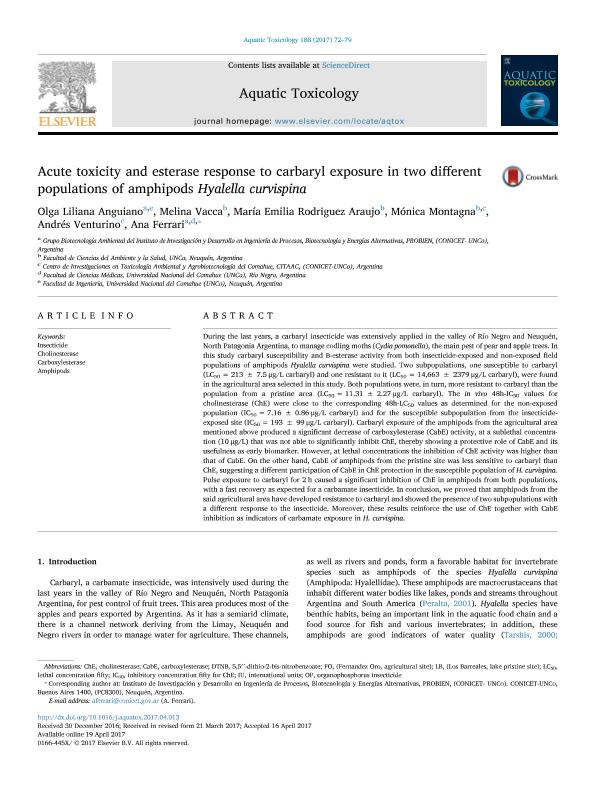Artículo
Acute toxicity and esterase response to carbaryl exposure in two different populations of amphipods Hyalella curvispina
Anguiano, Olga Liliana; Vacca, Melina; Rodriguez Araujo, María Emilia ; Montagna, Mónica; Venturino, Andres
; Montagna, Mónica; Venturino, Andres ; Ferrari, Ana
; Ferrari, Ana
 ; Montagna, Mónica; Venturino, Andres
; Montagna, Mónica; Venturino, Andres ; Ferrari, Ana
; Ferrari, Ana
Fecha de publicación:
07/2017
Editorial:
Elsevier Science
Revista:
Aquatic Toxicology
ISSN:
0166-445X
Idioma:
Inglés
Tipo de recurso:
Artículo publicado
Clasificación temática:
Resumen
During the last years, a carbaryl insecticide was extensively applied in the valley of Río Negro and Neuquén, North Patagonia Argentina, to manage codling moths (Cydia pomonella), the main pest of pear and apple trees. In this study carbaryl susceptibility and B-esterase activity from both insecticide-exposed and non-exposed field populations of amphipods Hyalella curvispina were studied. Two subpopulations, one susceptible to carbaryl (LC50 = 213 ± 7.5 μg/L carbaryl) and one resistant to it (LC50 = 14,663 ± 2379 μg/L carbaryl), were found in the agricultural area selected in this study. Both populations were, in turn, more resistant to carbaryl than the population from a pristine area (LC50 = 11.31 ± 2.27 μg/L carbaryl). The in vivo 48h-IC50 values for cholinesterase (ChE) were close to the corresponding 48h-LC50 values as determined for the non-exposed population (IC50 = 7.16 ± 0.86 μg/L carbaryl) and for the susceptible subpopulation from the insecticide-exposed site (IC50 = 193 ± 99 μg/L carbaryl). Carbaryl exposure of the amphipods from the agricultural area mentioned above produced a significant decrease of carboxylesterase (CabE) activity, at a sublethal concentration (10 μg/L) that was not able to significantly inhibit ChE, thereby showing a protective role of CabE and its usefulness as early biomarker. However, at lethal concentrations the inhibition of ChE activity was higher than that of CabE. On the other hand, CabE of amphipods from the pristine site was less sensitive to carbaryl than ChE, suggesting a different participation of CabE in ChE protection in the susceptible population of H. curvispina. Pulse exposure to carbaryl for 2 h caused a significant inhibition of ChE in amphipods from both populations, with a fast recovery as expected for a carbamate insecticide. In conclusion, we proved that amphipods from the said agricultural area have developed resistance to carbaryl and showed the presence of two subpopulations with a different response to the insecticide. Moreover, these results reinforce the use of ChE together with CabE inhibition as indicators of carbamate exposure in H. curvispina.
Palabras clave:
Amphipods
,
Carboxylesterase
,
Cholinesterase
,
Insecticide
Archivos asociados
Licencia
Identificadores
Colecciones
Articulos(CCT - PATAGONIA NORTE)
Articulos de CTRO.CIENTIFICO TECNOL.CONICET - PATAGONIA NORTE
Articulos de CTRO.CIENTIFICO TECNOL.CONICET - PATAGONIA NORTE
Articulos(PROBIEN)
Articulos de INST. DE INVESTIGACION Y DES. EN ING. DE PROCESOS, BIOTECNOLOGIA Y ENERGIAS ALTERNATIVAS
Articulos de INST. DE INVESTIGACION Y DES. EN ING. DE PROCESOS, BIOTECNOLOGIA Y ENERGIAS ALTERNATIVAS
Citación
Anguiano, Olga Liliana; Vacca, Melina; Rodriguez Araujo, María Emilia; Montagna, Mónica; Venturino, Andres; et al.; Acute toxicity and esterase response to carbaryl exposure in two different populations of amphipods Hyalella curvispina; Elsevier Science; Aquatic Toxicology; 188; 7-2017; 72-79
Compartir
Altmétricas



